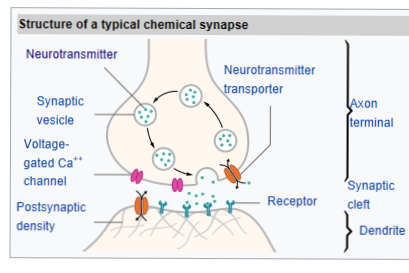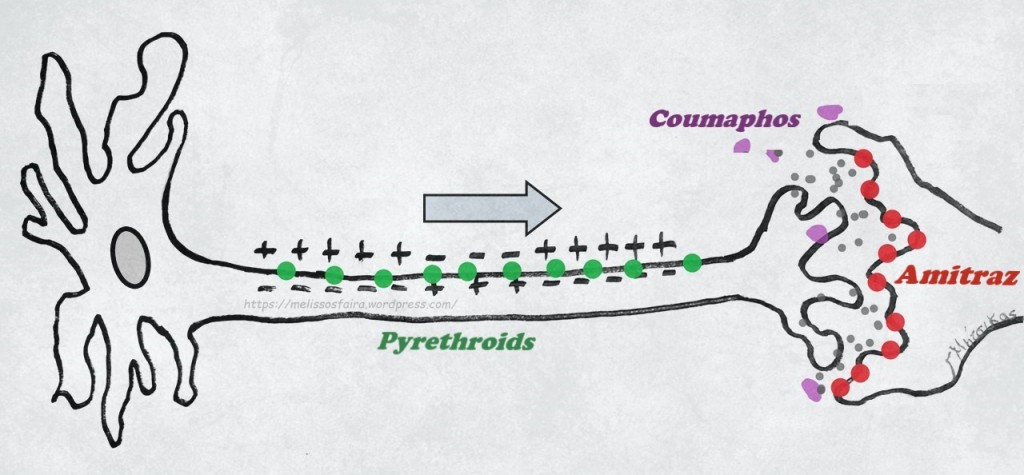Amitraz is a substance widely used to treat Varroa mite infestations in bees. It is popular because it is effective and has low residues in hive products. The emergence of Varroa mite infestations in recent decades has put beekeeping at risk, and beekeepers have increasingly relied on the use of synthetic acaricides. Varroa quickly developed resistance to synthetic acaricides, except for amitraz. The high cost of the approved treatments containing amitraz led beekeepers to use non approved formulations of the same active substance intended for mammals (Taktic and others) with homemade recipes. As a result, Taktic became the main formulation used in beekeeping worldwide, with no other substance currently available that could adequately replace it when it stops being effective. The topic of resistance was covered in a previous article.
*Note: this text was written in 2018. As a result, some information may be outdated: i.e. off-label practices were widespread and organic approaches were more improvised/marginalized*
In these articles, the mode action of Amitraz will be explained and both appropriate practices and improvised practices will be analyzed. A strange phenomenon of resistance observed in Taktic, as well as various problems created by improvised applications of Taktic, will also be examined. It should be clarified here that Taktic, Amitraz, and its metabolites are rapidly and timely degraded, thus minimizing the risks to honey consumers ¹³. The substance residues tend to decrease over time, unlike the residues of older acaricides that tend to build up. Of course, in all products related to productive animals, there are cases of irresponsible abuse. Fortunately, in such cases of Taktic abuse, the consumer is not at great risk due to the low residual toxicity of the substance in honey. However, laboratories are able to detect even minimal amounts of these residues in honey in case of malpractice.
The complex action of Amitraz
Amitraz is an insecticide of the formamidine family. Formamidines have a complex action on the nervous system of insects and mites that has not been fully understood. Their main feature is that they turn toxic again when the athropod detoxifies them. Through the natural processes of detoxification called N-demethylation, formamidines are “activated” biologically and thus, instead of reducing their toxicity, they are prolonged 1,2. Certain metabolites of formamidines after this activation mimic a neurotransmitter of nerve cells, octopamine, and take its place (as “agonists”) causing nerve and behavioral damage. The complex action of formamidines is attributed to the fact that the role of octopamine in these organisms is also complex. Octopamine is not only a neurotransmitter, but also a neuromodulator and a neurohormone 3. It regulates important physiological processes such as metabolism, reproduction, and behavior in arthropods.

Approved Applications for Honey Bees
Amitraz is a contact acaricide. Taktic is a solution of amitraz in aromatic hydrocarbons and therefore it may act by evaporation. There are two slow-release amitraz formulations suitable for bees available on the global market: Apivar (Vetopharm) and Apitraz (Calier). Both have stable efficacy and very good tolerance by bees. There are also amitraz formulations of controversial suitability, usually from China, Russia, Turkey, etc. Such products include Bipin, Amicel, Kenaz and others. They are unsuitable formulations for honey bees.

The off-label uses (Taktic)
There are common, acceptable, and low-risk practices for using Amitraz via the Taktic formulation. However, before proceeding, we need to clarify a misconception. Taktic is used because of its active substance, but the active substance does NOT make the drug by itself. Taktic contains heavy (aromatic) hydrocarbons. Practically, is not the same drug as those made for bees.
- Use with oil. An amount of Taktic is dissolved in a bottle with sunflower oil (or corn oil), and strips of Vettex sponges or paper towels are soaked in the mixture. The strips are placed between the frames and changed every few days. Less commonly, soaked wooden examination sticks are used. There are also variations in which the towels are placed at the entrance of the hive, etc.
- Use with water. An amount of Taktic is dissolved in water, and the solution is applied to the bees between the frames of the hive. The concentration of Amitraz that is usually used is equivalent to a lethal concentration for Varroa. This use it was also called “flash” treatment because it only kills Varroa located on the bees. There have to be some repetitions in order to kill the next Varroa that will hatch out of the sealed brood. The water method dramatically multiplies the absorption and distribution of the substances compared to the method with sunflower oils. That is, it completely changes the way amitraz is absorbed and distributed.
The mode of action of amitraz
Now let’s see the path of amitraz in the organism of the mite. Here, we need to delve into the fields of biochemistry.
- Amitraz is absorbed by the mite.
- It is distributed in the tissues, (central nervous system, sympathetic nervous system, etc.)
- From there, the amitraz molecule “hits” at least three key points, depending on the concentration to which the tick has been exposed.
A certain amount of amitraz is metabolized by the mite. This breakdown produces the molecule DMPF, which is again a formamidine and has the main neurotoxic effect ¹. - The breakdown produces other molecules, but the main metabolites are three. The DMPF molecule has a similar shape to the neurotransmitter octopamine. When DMPF reaches the cells of the mite’s central nervous system, it attacks the target system, which is the receptors of the neurotransmitter (octopamine). DMPF is an “antagonist” of octopamine in biological terms. That is, it “passes” as a neurotransmitter and “blocks” the receptor ⁴.
- Meanwhile, DMPF binds to an enzyme, monoamine oxidase. The role of monoamine oxidase in arthopods is to break down certain neurotransmitters and thus regulate balance in nervous systems (at neural synapses).
A study in arthropods found that the intact molecule of amitraz also exhibits toxicity and, despite its large size, it also affects octopamine receptors ⁴.
With the monoamine oxidase disabled and the octopamine receptor inhibited, the neurotransmitters accumulate rapidly at neural synapses, causing hyperstimulation.
As we mentioned before, the effects of amitraz on the mite depend on the concentration. The death of the varroa mite can result either from direct neurotoxic damage (at high concentrations), or from behavioral and reproductive problems (prolonged exposure to sublethal concentrations). Death from sublethal concentrations is characteristic of formamidines. Note that the knowledge of these mechanisms stems from studies on organisms with similar nervous systems to that of the varroa mite, such as ticks, etc. The Varroa mite has not been directly studied to such extend.

Amitraz is very unstable under acidic pH conditions and undergoes hydrolysis, producing DMPF (under moderate acidic pH). This is the reason why old emulsified solutions of amitraz continue to be effective against Varroa mites.
Toxicity on honeybees
The good tolerance of bees to amitraz compared to Varroa is due to the fact that bees metabolize it thousands of times slower than Varroa (slower N-demethylation). Furthermore, pharmacokinetic studies ⁵ have shown that the metabolism of amitraz is much more complex. The metabolism of bees may also use detoxification enzymes. In another study however, when these enzymes were deactivated in another study, the toxicity of amitraz did not change significantly ⁶. The metabolism of amitraz by bees has not been clearly defined. Perhaps amitraz or its metabolites are inert in bees than in Varroa.

If we somehow bypass the amitraz pre-molecule and expose bees directly to DMPF and other metabolites, then we expect the bee’s neurotransmitter systems, starting with the heart function, to be immediately affected ⁷ ¹². This is why old solutions of amitraz should not be used. Different results were shown by another study, which did not find significant effects on the behavioral functions of bees when exposed to amitraz for short periods ⁸ .
In high concentrations, of course, amitraz becomes directly toxic to the bee. Also, we should emphasize that the toxicity of amitraz has been studied a lot, but it cannot be compared with the much greater toxicity of Taktic.
Reports on Resistance
Regarding slow-release formulations, studies are often conducted that do not show resistance of varroa to the specific application method and to amitraz (from Veto Pharm and Calier). We found two studies, one from Argentina ⁹ and one from Mexico ¹⁰, which show low to moderate resistance of varroa to amitraz. The calculated resistance, which would be sufficient to render a drug useless, should be much higher, for example, a hundred times higher (as in biochemistry, the “amounts” do not follow real life proportions). However, these data show that varroa can evolve under certain conditions and become more resistant to Amitraz. We should not be reassured by the fact that we have slow resistance development compared to the years that Amitraz has been used.
Note that the experiments were carried out under special conditions (which facilitated maximum absorption of Amitraz), so these results are not necessarily related to those that would be observed in a beekeeping operation. Things are even more complex, and ultimately, as we will see in part II, varroa can defend itself with another type of resistance.
George Mitsikas (Chemist, Amateur Beekeeper)
Alexia Kalamida (Drug Technician)
published January 2019
*It is not allowed to copy and/or republish this article or part of it, without permission from the authors*
BIBLIOGRAPHY – COMMENTS
We warmly thank all beekeepers (professional and amateur) who shared their comments. Special thanks to Charalambos Vachliotis – professional beekeeper, for his contribution to the creation of the article.
- It follows Hollingworth’s research on formamidines in 1976. Activation occurs through the metabolic process of N-demethylation. Hollingworth, R. M. «Chemistry, biological activity, and uses of formamidine pesticides.» Environmental Health Perspectives 14 (1976): 57-69.
- Evans, Peter D., and Julian D. Gee. «Action of formamidine pesticides on octopamine receptors.» Nature 287.5777 (1980): 60.
- Farooqui, Tahira. «Review of octopamine in insect nervous systems.» Open Access Insect Physiol 4 (2012): 1-17.
- A detailed study on the mechanism in organisms confirmed that the main action of the drug is on Octopamine receptors. Kita, Tomo, et al. “Amitraz and its metabolite differentially activate α‐and β‐adrenergic‐like octopamine receptors.” Pest management science 73.5 (2017): 984-990.
- Hillier, Neil Kirk, Elisabeth H. Frost, and Dave Shutler. «Fate of dermally applied miticides fluvalinate and amitraz within honey bee (Hymenoptera: Apidae) bodies.» Journal of economic entomology 106.2 (2013): 558-565.
- Johnson RM, Dahlgren L, Siegfried BD, Ellis MD (2013) Acaricide, Fungicide and Drug Interactions in Honey Bees (Apis mellifera). PLoS ONE 8(1): e54092. https://doi.org/10.1371/journal.pone.0054092 Published: January 29, 2013
- Amitraz affects the heart of the bee. The DMPF is even more influential. The study on the cardiac effect of amitraz is as follows: Papaefthimiou, Chrisovalantis, Alexandros Papachristoforou, and George Theophilidis. «Biphasic responses of the honeybee heart to nanomolar concentrations of amitraz.» Pesticide biochemistry and physiology 107.1 (2013): 132-137.
- Rix, Rachel R., and G. Christopher Cutler. «Acute exposure to worst-case concentrations of amitraz does not affect honey bee learning, short-term memory, or hemolymph octopamine levels.» Journal of economic entomology 110.1 (2016): 127-132.
- Maggi, Matías D., et al. «Resistance phenomena to amitraz from populations of the ectoparasitic mite Varroa destructor of Argentina.» Parasitology research 107.5 (2010): 1189-1192.
- Rodríguez-Dehaibes, Sóstenes R., et al. «Resistance to amitraz and flumethrin in Varroa destructor populations from Veracruz, Mexico.» Journal of Apicultural Research 44.3 (2005): 124-125.
- Semkiw, Piotr, Piotr Skubida, and Krystyna Pohorecka. «The amitraz strips efficacy in control of Varroa destructor after many years application of amitraz in apiaries.» Journal of Apicultural Science 57.1 (2013): 107-121.
- Update 2023: There are too many anecdotal reports for resistance to both Apitraz and Apivar. Rinkevich et al confirmed it on 2020. See Rinkevich FD (2020) Detection of amitraz resistance and reduced treatment efficacy in the Varroa Mite, Varroa destructor, within commercial beekeeping operations. PLoS ONE 15(1): e0227264.
- Update 2023: Not exactly, as in fact, Taktic leaves persistent nonylphenol residues especially in wax and propolis. Nonylphenol compounds have been restricted in EU since 2019, hence the discontinuation of Taktic in EU.

Leave a comment